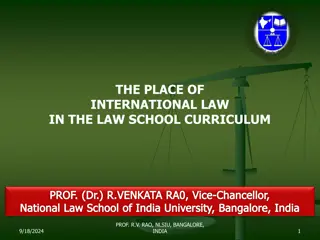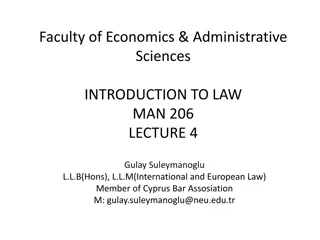Understanding the State and Law: Key Concepts and Perspectives
The discussion delves into the essence of the state and law, exploring various theoretical approaches such as social, Marxist, and political-legal perspectives. It defines the state as the main institution of the political system integrating social classes, powers, and politics, with persistent features like public authority, sovereignty, and monopoly rights. The intertwined nature of state, power, and politics is elucidated through different lenses, shedding light on how the state functions in society.
Download Presentation

Please find below an Image/Link to download the presentation.
The content on the website is provided AS IS for your information and personal use only. It may not be sold, licensed, or shared on other websites without obtaining consent from the author. Download presentation by click this link. If you encounter any issues during the download, it is possible that the publisher has removed the file from their server.
E N D
Presentation Transcript
Some Issues of Theory of State and Law
1. The State, its Qualifications and Forms (3- 16). 2. The Concept of Law; Legal Norm; Sources of Law (17-30). GENERAL QUESTIONS
The state: Is the main institution of the political system of society that organizes, directs, and controls the joint activities and relationships of people, groups, social strata, classes, organizations, etc.; Is the major institution of power; Public authorities implement their policies by means of the state. The State, its Qualifications and Forms
The concepts of state, power, and politics are closely interconnected and interdependent. There are three major theoretical approaches to understanding the essence of the state: Social; Class (Marxist); Political and legal. The State, its Qualifications and Forms
Social approach: The state is a means of solving common problems which regulates the relations between rulers and people. Class (Marxist) approach: The state appeared with the division of society into social classes and serves as an instrument of class domination, the suppression of some social classes by other social classes. Political and legal approach: The state is a source of law that organizes the life of society and the state itself. The State, its Qualifications and Forms
The state has some persistent features: 1. The presence of public authority possessing a certain social, class, and economic foundation; 2. The existence of a special political organization; 3. The division of the population into territorial units (territorial division of the population throughout the country); The State, its Qualifications and Forms
The state has some persistent features: 4. Sovereignty, i.e. independence in external and internal affairs; 5. Performing of a number of functions which are based on certain responsibilities towards society: protection of the territory, crime control, etc.; 6. Securing a number of monopoly rights: issuing laws, printing banknotes, collecting taxes, etc. The State, its Qualifications and Forms
The state always has a certain form which depends on the characteristics of the form of government and political regime. In terms of the form of government, the states differ depending on how the authorities are formed, how the relations between them are established, and who possesses the supreme power: The State, its Qualifications and Forms
If the supreme power is exercised by one person and is acquired by inheritance, then this is a monarchy; If the supreme authorities (in the modern world this is usually a parliament) are elected in popular elections, then this is a republic. The State, its Qualifications and Forms
Monarchies can be: Absolute (power is exercised by the monarch); Constitutional or parliamentary (the power of the monarch is limited by the legislative power of the representative body that forms the executive branch); Dualistic monarchies in which legislative power is vested in representative bodies subordinate to the monarch who heads the executive branch. The State, its Qualifications and Forms
Republics can be: Presidential: the president combines the powers of the head of state and government, is not directly responsible to the parliament, and cannot dissolve it (USA); Parliamentary: the president is the head of state, but executive power is exercised by the prime minister of the government formed by the parliament (Germany); Mixed: has features of both parliamentary and presidential republic; strong presidential power is combined with broad parliamentary rights (France). The State, its Qualifications and Forms
The form of government is determined by the division of the country into administrative and territorial units and autonomous entities: From this viewpoint, unitary and federal states can be distinguished. The political regime is characterized by a combination of means and methods of exercising state power; political regimes can be: Democratic; Anti-democratic (authoritarian and totalitarian). The State, its Qualifications and Forms
Manifestations of a democratic regime: Government is based on the consent of the governed; Majority rule (decisions are adopted by a majority of votes with respect for the will of the minority); Strict observance of human rights and freedoms; Free and fair elections; The State, its Qualifications and Forms
Manifestations of a democratic regime: Equality of citizens before the law; Independent legal proceedings; Social, political, ideological, and other pluralism; Tolerance, cooperation, willingness to compromise. The State, its Qualifications and Forms
Manifestations of a totalitarian regime: Tyrannical, dictatorial power; Total control over the behavior, activities, and thinking of people; Extrajudicial repression; Militarization of public life; On -party system and mono-ideology. The State, its Qualifications and Forms
Manifestations of an authoritarian regime: The government, as a rule, respects basic civil liberties, but behaves very strictly towards society; Political and often economic power is concentrated in the hands of one person or a group of persons; Government is based on the use of force; Elections are held irregularly and are often falsified; The media do not reflect the full range of opinions of various segments of the population. The State, its Qualifications and Forms
Law: Is a universal mechanism for regulating public relations; Is a single and holistic system; Is a set of binding rules (norms) established by the state; The state: Establishes certain rules of law; Ensures their implementation, punishes for violation, and enforces compliance. Legislation is the form of expression and consolidation of the rule of law. The Concept of Law; Legal Norm; Sources of Law
The legal system is understood as the internal organization of law, an ordered set of legal norms. The structure of the legal system can be viewed vertically and horizontally. There are three levels in the vertical structure of law: The branch of law; The institution of law; The rule of law. The Concept of Law; Legal Norm; Sources of Law
The branch of law: Is a separate group of legal norms and institutions united by the similarity of social relations that they regulate; Each branch of law has its own subject of regulation, its own type of social relations, which possess an obvious specificity; The main branches of law are constitutional, civil, labor, family, administrative, financial, criminal, procedural (civil, criminal, arbitration), etc. The Concept of Law; Legal Norm; Sources of Law
Law institutions are: Separate groups of legal rules governing homogeneous social relations, but smaller than branches; Included in the corresponding branches of law. Such institutions are those of citizenship or human rights that are part of the branch of constitutional law. The Concept of Law; Legal Norm; Sources of Law
A legal norm (rule of law) is a general rule of conduct established by the state that regulates public relations through it. The rules of law are structured and subdivided into types. The structure of a legal norm includes: Hypothesis; Disposition; Sanction. The Concept of Law; Legal Norm; Sources of Law
The hypothesis indicates the circle of persons to whom the norm is addressed, as well as the circumstances in which it is implemented. Disposition is the rule of conduct itself, in which the rights and obligations of individuals are established. The sanctions contain measures of state coercion that apply to offenders. The Concept of Law; Legal Norm; Sources of Law
By type of rule, the law is divided into: Authorizing provides citizens with an opportunity to act accordingly; Binding requires proper behavior; Prohibiting establishes prohibitions on certain actions. The Concept of Law; Legal Norm; Sources of Law
In Russia, the sources of law are laws, by- laws, and treaties. In Great Britain, the USA, and other countries, the formation of the legal system of which was greatly influenced by English law, precedents play an important role. In Russia, precedents are used very rarely. In the countries with strong patriarchal traditions, customs play a significant role. The Concept of Law; Legal Norm; Sources of Law
The law is realized in the following forms: Normative acts which are divided into laws (constitutional and ordinary) and by-laws (decrees, instructions, orders, etc.); Legal precedents (patterns of behavior, actions in certain situations) which can be judicial and administrative; Customs which are the rules of behavior prevailing in society that the state takes under its protection and gives them the force of legal norms; Contracts giving rise to legal relations (obligations) that disappear after the conditions of a contract are fulfilled. The Concept of Law; Legal Norm; Sources of Law
The horizontal structure of law allows its classification by branch. Manifestations of the law are: Regulatory nature the presence of certain norms and rules of conduct; Mandatory implementation of the rule of law by all participants in public life; Approval and guarantee of the rule of law by the state; Repeated use. The Concept of Law; Legal Norm; Sources of Law
The functions of the law: It is a regulator of public relations; It actively influences society and the state by establishing generally binding rules of conduct; It consolidates the existing economic, social and other relations, as well as the existing state and social system. The Concept of Law; Legal Norm; Sources of Law
The main features of the rule of law state are: Equal responsibility before the law of all citizens and state bodies from top to bottom; The triumph of legality as a principle for organizing the life of society; A clear separation of powers into legislative, executive, and judicial ensuring a strong and independent judiciary; The absence of any significant contradictions between the branches of government; The Concept of Law; Legal Norm; Sources of Law
The main features of the rule of law state are: Advanced legal culture of the population; Guarantees of respect for human rights; It does not tend to establish petty tutelage of civil society and its individual members; Civil society is self-governing and able to exert a decisive influence on the policies of the state, as well as on the development of law. The Concept of Law; Legal Norm; Sources of Law
The foundation of law is justice as its original, ideal essence. Therefore, the concepts of right and law are not identical. A law can be unjust, and therefore unlawful (e.g., the Law of Three Spikelets in the USSR). The Concept of Law; Legal Norm; Sources of Law























